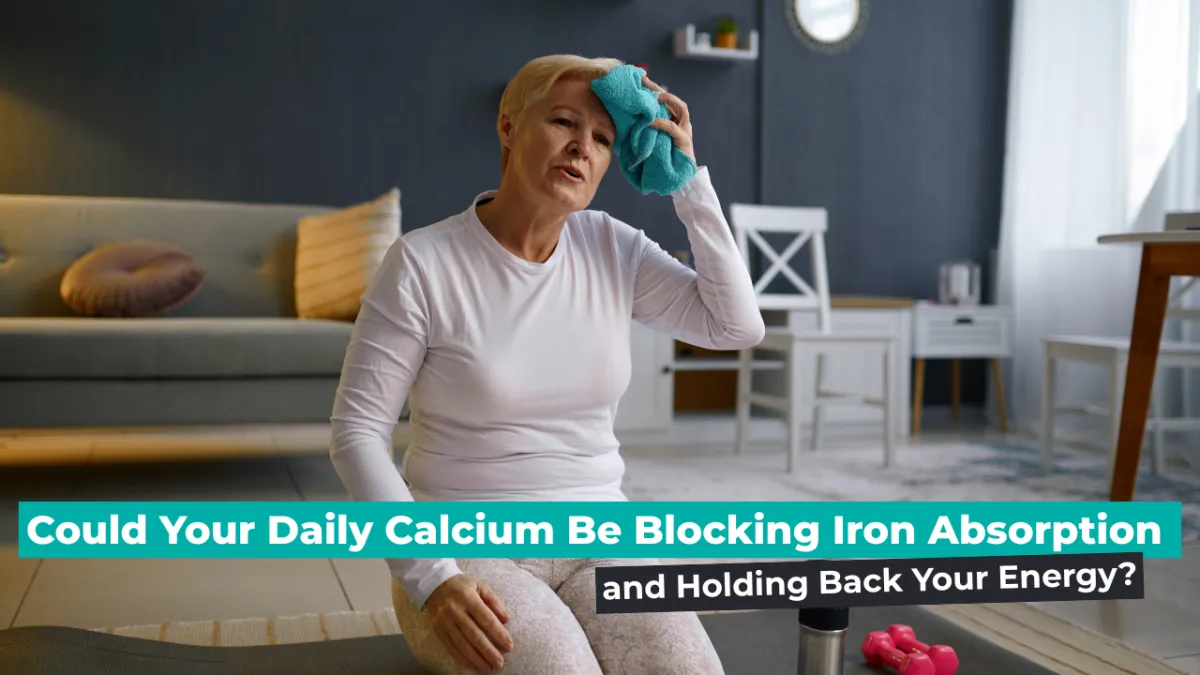
The PrimeFit Journal
Health, strength and mindset coaching for midlife professionals.
Whether you’re over 40, managing a condition like Type 2 diabetes or PCOS, or simply training with more purpose, this is your evidence-based resource for building real strength and lasting energy—without gimmicks or overwhelm. I’m Rob, a personal trainer and nutrition coach, and I use this space to help you live better through smart, sustainable choices.

Could Your Daily Calcium Be Blocking Iron Absorption – and Holding Back Your Energy?
If you've ever felt like you're ticking all the right boxes—eating well, exercising, taking supplements—but still waking up tired, it might not just be “midlife”. It could be a quiet clash happening inside your gut: calcium blocking iron.
For men and women in their 40s to 60s, especially those trying to improve energy, mood, and long-term health, understanding how these two key minerals interact can be a game-changer.
The Hidden Tug-of-War Between Calcium and Iron
Iron and calcium are both essential. But here’s the catch: when you eat or supplement them at the same time, calcium can reduce your body's ability to absorb iron—particularly the type found in plant-based foods (non-heme iron).
If you're adding milk to your porridge and chasing it with a multivitamin, or throwing spinach and feta into a smoothie, your body might only be getting part of the iron you think it is.
This interaction doesn’t mean you should cut either one—just that timing matters.
Why This Especially Matters in Midlife
In your 40s and 50s, energy dips, poor sleep, and stubborn fatigue often get brushed off as “just aging”—but for many, they're symptoms of low iron. And if you’re eating well but still feeling drained, it’s worth asking if calcium is interfering with absorption.
Women, in particular, face a double challenge. Menstrual blood loss can deplete iron stores, and perimenopause can bring heavier periods before they stop altogether. Combine that with a diet rich in dairy or supplements—and you’ve got a recipe for chronic under-absorption.
For men, the story’s a bit different. While they’re less likely to be iron-deficient, low iron can creep in—especially if there’s a reliance on calcium supplements for bone health or if they follow a mostly plant-based diet.
Iron, Mood, and That Afternoon Slump
Iron doesn’t just help with oxygen transport—it also supports dopamine and serotonin production, which regulate your mood and focus. Low iron can show up as brain fog, irritability, or that frustrating sense of just not feeling quite “on it”.
Combine that with the seasonal dip in vitamin D during darker months, and you’ve got the perfect storm for sluggishness—physical and emotional.
So, What Should You Actually Do?
Here’s how to optimise both iron and calcium without ditching either:
1. Space Them Out
If you take a calcium supplement, avoid pairing it with your main iron-rich meal. Same goes for milky teas or coffee. Give yourself a few hours between calcium and iron-rich foods.
2. Use Vitamin C to Your Advantage
Vitamin C can boost non-heme iron absorption by up to 300%. Add peppers, citrus, or a handful of berries to iron-containing meals.
3. Rethink “Healthy” Breakfasts
A lot of midlifers fall into the pattern of cereal + milk + tea = low iron uptake. Instead, try a veggie-packed omelette or overnight oats with water or fortified plant milk.
4. Check Your Multivitamin
If your all-in-one supplement stacks calcium and iron together, it may be time to split your doses or switch to a format designed for better absorption.
5. Track Your Energy and Symptoms
If you’ve been told your iron is “borderline” but still feel wiped out, it may not be low enough to trigger a red flag—but it might still be low for you. Use your food diary to log how meals affect your energy and mood.
Final Word: Personal Health Is a Puzzle—Start Matching the Pieces
For midlife professionals, the goal isn’t just to survive the day—it’s to feel sharp, capable, and energised again. If you’ve been struggling with that “ugh” feeling even when you’re doing the right things, don’t ignore the micronutrients.
This is exactly the kind of detective work we do inside the PrimeFit coaching programme—looking beyond surface-level advice to identify hidden blocks and create sustainable, high-impact change.
References
Cook JD, Dassenko SA, Whittaker P. Calcium supplementation: effect on iron absorption. Am J Clin Nutr. 1991;53(1):106–11. doi:10.1093/ajcn/53.1.106
Cegarra L et al. Calcium is a noncompetitive inhibitor of DMT1 on the intestinal iron absorption process. Am J Physiol Cell Physiol. 2022;323(6):C1791–C1806. doi:10.1152/ajpcell.00411.2022
Lynch SR, Cook JD. Interaction of vitamin C and iron. Ann N Y Acad Sci. 1980;355:32–44. doi:10.1111/j.1749-6632.1980.tb21325.x
Ito T, Jensen RT. Association of long-term PPI therapy with effects on calcium, vitamin B12, iron, and magnesium absorption. Curr Gastroenterol Rep. 2010;12(6):448–57. doi:10.1007/s11894-010-0141-0
Zijp IM, Korver O, Tijburg LB. Effect of tea and other dietary factors on iron absorption. Crit Rev Food Sci Nutr. 2000;40(5):371–98. doi:10.1080/10408690091189194
Hurrell R, Egli I. Iron bioavailability and dietary reference values. Am J Clin Nutr. 2010;91(5):1461S–1467S. doi:10.3945/ajcn.2010.28674F
Copyright 2025 Ede Fitness, All Rights | Privacy Policy | Terms & Conditions

